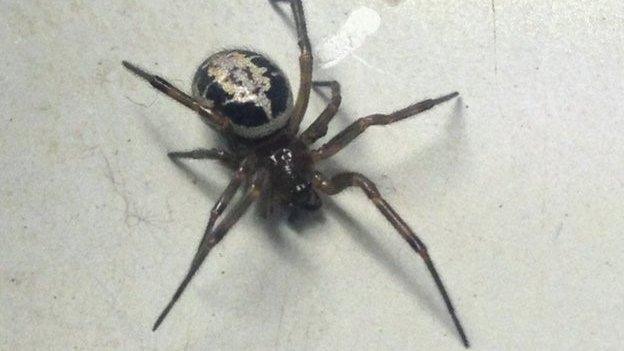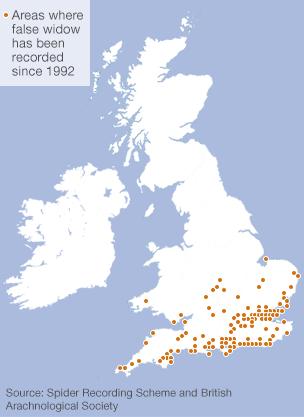Perils of the English countryside
- Published
Most people would be wary of crossing a large snorting bull in a field but, every year, scores of people are injured or even killed by other animals in the English countryside.
Many are creatures that may not instantly spring to mind - and have caused injury or terrified people who were otherwise enjoying a rural idyll.
But which animals are dangerous and why do they attack?

Cows

Statistically, cows injure about three times more people than bulls
Cows account for at least as many deaths as bulls - and can be very unpredictable, particularly when young calves are close by.
Sarah Leonard, a nurse from Sheffield, survived being trampled by a herd of cows while with her dog in North Scarle, Lincolnshire, in November.
She suffered two broken arms, a broken collar bone and several broken ribs and spent five weeks in hospital, two of which were in intensive care.
Ms Leonard said: "I was on a four mile circular walk when I saw the cows coming towards me and I shouted and waved my arms - then I can't remember any more."
She described it as a "terrifying experience" and her ordeal was not helped when during a 999 call she was accused of being a hoaxer.
Lincolnshire farmer, John Stone, who has worked with cattle for 60 years, said people did not realise how dangerous they could be.
"The biggest danger is when there are cows with their calves," he said.
"You are talking about a cow which can weigh anything from 650kg to 1,000kg and, quite frankly, she will stop at nothing to protect her young."

Sarah Leonard was reunited with her dog, Meggie, after she was found hiding in bushes following the attack

Wild boar

Wild boars are usually very timid but may attack dogs, says the UK Wild Boar Association
Boars have roamed wild in the Forest of Dean, in Gloucestershire, since 2004, when they were reintroduced after an absence of 700 years.
The animals, which can weigh up to 330lbs (150kg), were native to England but were hunted to extinction in the wild in the 17th Century.
Damage to gardens, danger to dog walkers and riders and boar-related road accidents have made them unpopular with some.
Last year, the Gloucester Citizen, external reported dog walkers in the forest were scared to take their animals out after a rise in the number of wild boar attacks.
One account said a boar chased a dog, before turning on the dog's owner - who scrambled up a tree to get away.
The Forestry Commission said it had received reports of dogs being attacked and horses being spooked by boar in the forest.
"Wild boar really aren't dangerous if they are not put in a situation where they feel threatened," says Scott Passmore, co-founder of the UK Wild Boar Association.
"They are very timid, but like any animal if they are fed they can become tame and that's when you run into problems."
He said boar would have lived in the wild alongside wolves in Britain, so when they see a dog their reaction can be to "stand and fight".

Some residents living in parts of the Forest of Dean said wild boar were causing them misery by foraging for food

Adders

Adders are relatively common in some areas, including the Peak District and Cornwall
Adders are Britain's only venomous snakes and use their venom to immobilise prey such as lizards and small mammals.
The NHS said about 100 cases of adder bites were reported in the UK every year.
Since records began in 1876 only 14 people have been reported as having died from adder bites and the last was way back in 1975.
Most bites occur between February and October, with the number peaking during the summer.
However, a number of dog deaths have been attributed to adder bites, including a possible case in Nottinghamshire earlier this year.
In 2013, one vet said she had treated 15 animals that had been bitten by adders, including an English springer spaniel whose face "swelled to twice its size".
Jim Foster, from the Amphibian and Reptile Conservation Trust, said there were usually three reasons why an adder might bite a human.
"Either a person picks up - or attempts to pick up - the snake, or the person accidentally steps on the snake or puts their hand very close while trying to do something else," he said.
"In all cases, the adder is attempting to defend itself, rather than 'attacking', which is a common misconception.
"Similarly, adder bites on dogs tend to happen when dogs come across the snake and attempt to investigate it."

Deer

The British Deer Society said wild deer would normally move off quickly into cover when disturbed
More than 50,000 deer are hit by cars each year, according to the AA but the danger is not completely one way. There have also been a number of cases of people being attacked by the animals.
In 2013, a woman suffered facial injuries when a deer ran loose along Chelmsford High Street.
And in June, several people were chased by deer trying to protect their fawns at Richmond Park in south-west London.
Dog walker Jack Birrell said he had seen "quite a few [people]....running for their lives" during birthing season.
One man told him he was chased for 20 minutes and another couple said they had been chased by 11 hinds.
Several incidents of rutting stags attacking people in Bushy Park, south-west London have been reported in recent years.
One walker's bid to avoid a particularly aggressive animal in 2012 ended with him climbing a tree.
"Wild deer are normally timid animals and will move off quickly into cover when they have been disturbed by people," says Dave Goffin, of The British Deer Society.
"However, during the rutting season, which for the three larger species of deer is in the autumn, males with heightened testosterone levels can be more aggressive particular toward other intruding male deer.
"People are warned to be cautious of approaching too close to deer during this period as they may be mistaken for rivals within a male's rutting area."

False widow spider

Experts say the number of false black widows is on the increase, as existing populations expand
The UK's most venomous spider is thought to have arrived in England in crates of fruit from the Canary Islands in the late 19th Century, with the first reported sighting in Torquay in 1879.

The spider, which is about the size of a 50p piece, belongs to the same family as the black widow, although its bite is nowhere near as toxic.
The severity of symptoms depends on the amount of venom injected but can include severe swelling, chest pains and tingling of fingers.
Alison Blackburn, from Strood in Kent, was bitten by one in January, while sleeping and she needed hospital treatment to drain the venom from her left foot.
In another incident, Steve Harris, was bitten in his sleep in Devon and had to undergo an emergency operation.
He said: "They had to cut away the area around the bite to get at the poison.
"I was in agony. I have never had pain like that before in my life."
However, Sara Goodacre from the University of Nottingham's Spider Lab, said there seemed to be a "disproportionate worry" about the creatures.
She said some media reports of bites were not consistent with the effect a neurotoxin - present in a false widow's venom - would have.
"False widow spiders should not be a problem as they are not aggressive," she added.
The UK has about 650 species of spider and of these only about a dozen are capable of biting humans.



Ticks

Ticks can transmit Lyme disease, which can cause arthritis and even death if untreated
Perhaps one of the most underestimated creatures frequenting the countryside is the tick.
Experts have warned that ticks - blood-sucking, disease-carrying arachnids - appear to be on the rise.
Lyme disease, an infection that can cause arthritis and even death if untreated, can be transmitted to humans through its bite.
One victim, Joanne Drayson, was infected after walking in woods near her home in Guildford, Surrey.
In 2003, she remembers finding a tick on her foot, which caused a rash. At the same time she had flu-like symptoms that lasted several weeks.
When Mrs Drayson was bitten again two years later, she developed symptoms similar to arthritis, but doctors still did not suspect that the ticks had infected her with Lyme disease.
Her health deteriorated to such an extent that she was unable to lift her legs or arms. The pain in her hips meant she was unable to climb stairs in her own home.
It was 2007 before she was given a clinical diagnosis, after her GP prescribed antibiotics for a chest infection and they dramatically improved her symptoms.
She said: "I had removed ticks from my dogs for over 30 years, but didn't really know much about them. There are probably thousands of people who could end up like me."
Official estimates put the number of new UK cases each year at around 3,000, but Lyme disease charities say the figure could be as high as 15,000 annually because so many people do not have their condition diagnosed.
However, Richard Wall, professor of Zoology at Bristol University, said: "While it's important to be aware of the risks - only a very small proportion of ticks carry Lyme disease."
He added that ticks were most prevalent in areas with large numbers of their preferred host, red deer.